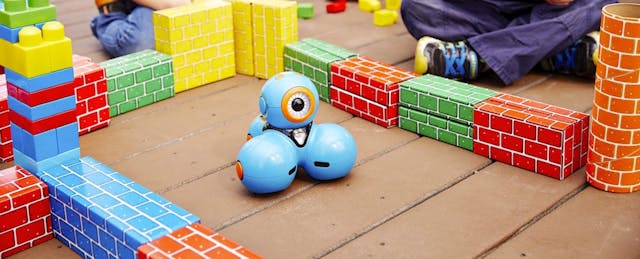Wonder Workshop is dashing towards new markets, especially China.
The maker of Dash and Dot has raised a $20 million Series B round led by WI Harper Group and Idea Bulb Ventures with participation from Learn Capital, Charles River Ventures, Madrona Venture Group and TCL. The company’s flagship products are two round blue robots aimed at introducing students age 6 to 12 to computational thinking. Students use an iOS or Android app to code commands for the robots.
The funding will go towards entering markets beyond American borders. Wonder Workshop claims that more than 4,000 elementary schools in the US and 2,000 across the rest of the world have incorporated Dash and Dot into their curricula already. The numbers speak to rapid growth: Wonder Workshop founder and CEO Vikas Gupta said that while no schools were using Dash and Dot in early 2015, the purchases started coming in. By the end of 2015, 1,500 schools—mostly American—had adopted it. Wonder Workshop has shipped almost 150,000 robots in the past year and a half. Dash retails for $150; Dot for $50.
The company will make Dash and Dot available in Australia, South Korea, China, South America and Europe. Of those markets, Wonder Workshop will focus its international efforts on China and Europe, where the company has already seen strong adoption without much marketing or content localization.
To that end, the company will use the infusion of capital to hire educators and translators from these places to rewrite existing Wonder Workshop content to be culturally relevant and appealing to audiences in their own languages. The greater part of Wonder Workshop’s content is currently available in English only.
“In China, we’ve seen interest in Dash and Dot at all levels of education—in after-school learning centers, in classrooms and at home. Consumers would buy them in the US and take them back to China, even though everything about it was in English,” Gupta said. “That pointed us to a strong opportunity.”
The greatest challenge of this process, Gupta said, is transposing the personality of the content, especially of the robots themselves, that has been so successful in the United States. That’s why the company is also in search of Chinese and European animators and character designers.
Formerly a solely consumer-facing company, Wonder Workshop started working with schools and selling to them in 2015 after success with individual customers.
“We wanted our product has been aimed at both consumers and schools since the beginning, but we started with consumers,” Gupta said. “Now that we work much more closely with teachers, we love the feedback they give us, which allows us to improve the product for both teachers and consumers.”
In addition to the growth of sales to schools, Wonder Workshop has widened its retail reach. Dash and Dot were only available on Amazon in the first half of 2015. Now, consumers can buy the robots in Toys R Us, Barnes and Noble, Target and Best Buy. Consumer sales, Gupta said, are growing.
The company has also begun hosting Wonder League, a robotics competition for the network of clubs around the country dedicated to Dash and Dot. The clubs, like the robots, are aimed at students ages 6 to 12. The first competition was held in the fall of 2015, and Wonder Workshop plans to put it on annually for the foreseeable future. The theme of this year’s competition is “Saving the environment.” Signups are still open for school robotics clubs that have registered with Wonder Workshop; creating an official club is free for students and schools.
To compete, teams download a challenge document and must use Dash, Dot and the Wonder app to program solutions to the problems therein. To submit to the competition, clubs film their robots completing the challenges and send the videos to Wonder Workshop with written explanations of their code.
In the first year of the competition, 1150 teams participated, according to Wonder Workshop. This year, 5300 teams have registered to participate, but Gupta hopes that a total of 10,000 teams to sign up to play. The competition will be held through the month of October.
Gupta said he believes this funding will be focused on the next year to two years of growth and that he may return to investors to raise additional capital after that time elapses. He hasn’t thought of where the the company is heading in terms of an IPO or other major financial outcome.


